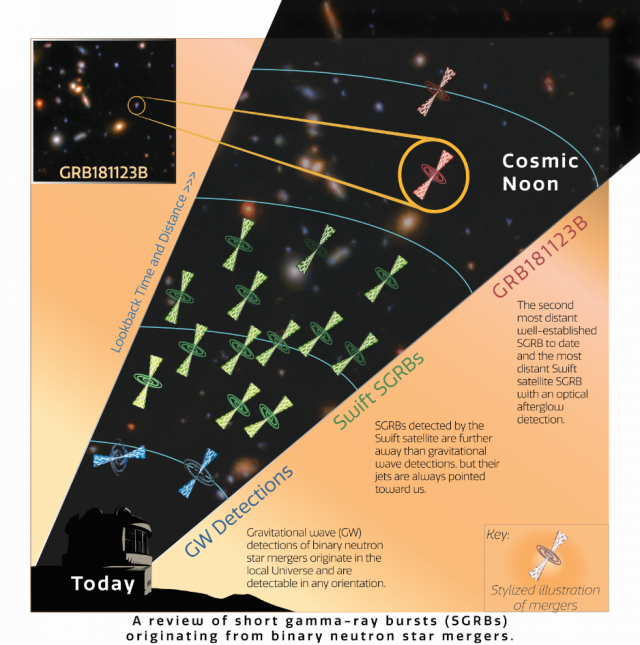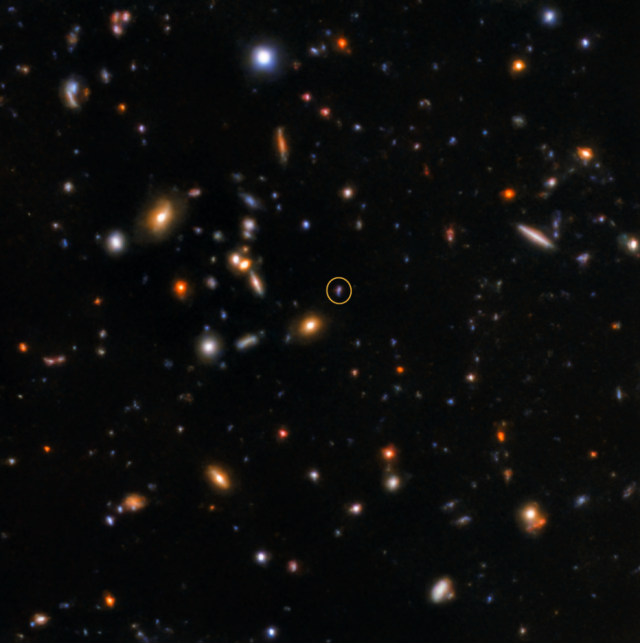Maunakea, Hawai‘i – Astronomers have discovered the second-most distant confirmed short gamma-ray burst (SGRB) ever studied using two Maunakea Observatories in Hawaiʻi – W. M. Keck Observatory and the international Gemini Observatory, a Program of NSF’s NOIRLab. Observations confirm the object’s distance at 10 billion light-years away, placing it squarely in the epoch of cosmic high noon when the universe was in its “teenage years” and rapidly forming stars.
The appearance of an SGRB at such an early time could alter theories about their origins, particularly the length of time it takes two neutron stars to merge and produce these powerful explosions, as well as the rate of neutron star mergers in the young universe.
“This was a very exciting object to study,” said Kerry Paterson, a postdoctoral associate at Northwestern University’s Center for Interdisciplinary Exploration and Research in Astrophysics (CIERA) and lead author of the study. “Our research now suggests neutron star mergers could occur surprisingly quickly for some systems — with neutron star binaries spiraling together in less than a billion years to create an SGRB.”
The study has been accepted in The Astrophysical Journal Letters and is available in preprint format on arXiv.org.
SGRBs are short-lived, highly-energetic bursts of gamma-ray light. The gamma-ray light lasts for less than two seconds, while the optical light can last for a matter of hours before fading. Therefore, rapid follow-up of the optical afterglow of these intense flashes of gamma-ray radiation is critical. Within just a few hours after NASA’s Neil Gehrels Swift Observatory detected the object and broadcast a worldwide alert, Paterson’s team quickly pointed the Gemini North and Keck I telescopes toward the location of the SGRB.
Using the Gemini Multi-Object Spectrograph followed by Keck Observatory’s Multi-Object Spectrograph for Infrared Exploration (MOSFIRE) instrument, the researchers were able to measure the very faint afterglow of the object, which is named GRB181123B because it was the second burst discovered on November 23, 2018 – Thanksgiving night.
“It was unreal,” said Wen-fai Fong, assistant professor of physics and astronomy at Northwestern University and co-author of the study. “I was in New York with my family and had finished having a big Thanksgiving dinner. Just as I had gone to sleep, the alert went off and woke me up. While somewhat of a nuisance, you literally never know when you’ll land a big discovery like this! I immediately triggered the Gemini observations and notified Kerry. Thankfully, she happened to be observing at Keck that night and was able to rearrange her original observing plan and repoint the telescope towards the SGRB.”
“It was such an adrenaline-rush to be at Keck when the SGRB alert went off and personally move the telescope towards the object to capture data mere hours after the burst,” said Paterson.
Precisely-localized SGRBs are rare, typically only 7–8 are detected per year. To pinpoint the distance of GRB181123B, the team obtained spectra of its host galaxy through follow-up observations using Keck Observatory’s DEep Imaging and Multi-Object Spectrograph (DEIMOS).
“Once we obtained the optical spectrum from DEIMOS, it was clear this event was one of the most distant SGRBs measured, which further fueled our investigation to determine its precise distance,” said Paterson.
This led the team to collect additional observations with Keck Observatory, along with the Gemini South telescope in Chile and Multi-Mirror Telescope in Arizona. With a distance calculated at a cosmological redshift of 1.754, the data confirmed the object is the most distant high-confidence SGRB with an optical afterglow detection ever found.

“The identification of certain patterns in the spectrum, together with the colors of the galaxy from the three observatories, allowed us to precisely constrain the distance and solidify it as one of the most distant SGRBs to date in 16 years of Swift operations,” said Paterson.
Once the team identified the host galaxy, they were able to determine key properties of the parent stellar population within the galaxy that produced the SGRB.
“Performing ‘forensics’ to understand the local environment of SGRBs and what their home galaxies look like can tell us a lot about the underlying physics of these systems, such as how SGRB progenitors form and how long it takes for them to merge,” said Fong. “We certainly did not expect to discover an extremely distant SGRB, as they are very rare and faint, but we were pleasantly surprised! This motivates us to go after every one that we possibly can.”
ABOUT MOSFIRE
The Multi-Object Spectrograph for Infrared Exploration (MOSFIRE), gathers thousands of spectra from objects spanning a variety of distances, environments and physical conditions. What makes this large, vacuum-cryogenic instrument unique is its ability to select up to 46 individual objects in the field of view and then record the infrared spectrum of all 46 objects simultaneously. When a new field is selected, a robotic mechanism inside the vacuum chamber reconfigures the distribution of tiny slits in the focal plane in under six minutes. Eight years in the making with First Light in 2012, MOSFIRE’s early performance results range from the discovery of ultra-cool, nearby substellar mass objects, to the detection of oxygen in young galaxies only two billion years after the Big Bang. MOSFIRE was made possible by funding provided by the National Science Foundation. It is currently the most in-demand instrument at Keck Observatory.
ABOUT DEIMOS
The DEep Imaging and Multi-Object Spectrograph (DEIMOS) boasts the largest field of view (16.7arcmin by 5 arcmin) of any of the Keck Observatory instruments, and the largest number of pixels (64 Mpix). It is used primarily in its multi-object mode, obtaining simultaneous spectra of up to 130 galaxies or stars. Astronomers study fields of distant galaxies with DEIMOS, efficiently probing the most distant corners of the universe with high sensitivity.
ABOUT W. M. KECK OBSERVATORY
The W. M. Keck Observatory telescopes are among the most scientifically productive on Earth. The two 10-meter optical/infrared telescopes on the summit of Maunakea on the Island of Hawai‘i feature a suite of advanced instruments including imagers, multi-object spectrographs, high-resolution spectrographs, integral-field spectrometers, and world-leading laser guide star adaptive optics systems.
Some of the data presented herein were obtained at Keck Observatory, which is a private 501(c) 3 non-profit organization operated as a scientific partnership among the California Institute of Technology, the University of California, and the National Aeronautics and Space Administration. The Observatory was made possible by the generous financial support of the W. M. Keck Foundation.
The authors wish to recognize and acknowledge the very significant cultural role and reverence that the summit of Maunakea has always had within the Native Hawaiian community. We are most fortunate to have the opportunity to conduct observations from this mountain.


